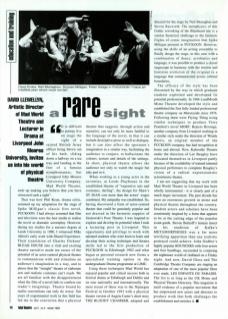‘It is difficult to portray live on stage the sight of a retired British Army officer being blown out of his bath, sliding down a hallway on a tea tray, and landing at the feet of a famous nymphomaniac, but Liverpool John Moores University Company, Mad World Theatre, ends up making you believe that you have witnessed such a sight.’
That was how Phil Kean, drama critic, summed up my adaptation for the stage of Spike Milligan's classic first novel, Puckoon. I had always assumed that film and television were the best media to realise the novel as dramatic screenplay. However, during my studies for a masters degree at Leeds University in 1980, I witnessed Mike Alfred's early work with Shared Experience. Their translation of Charles Dickens’ Bleak House into a vital and exciting theatre narrative made me aware of the potential of an actor-centred physical theatre to communicate with and stimulate an audience's imagination in a way, and to places, that the ‘straight’ theatre of elaborate sets and realistic costumes can't reach. We are all familiar with the disappointment when the film of a novel fails to confirm our reader's imaginings. Theatre bound by realist conventions can only do worse. Ten years of experimental work in this field has led me to the conviction that a physical theatre that suggests, through action and narrative, can not only be more faithful to the language of the novel, in that it can include descriptive prose as well as dialogue, but it can also affect the spectator's imagination in a similar way, facilitating the audience to conjure, to hallucinate the colours, texture and details of the settings. In short, physical theatre allows the audience not only to watch the magic but take part in it.
When working as a young actor in the seventies, at Leeds Playhouse in the established theatre of ‘expensive sets and costumes, darling’, the design for Shaw's St Joan cost more than the actors' wages combined. My antipathy was established. So, having discovered a form of actor-centred theatre that could be genuinely popular and not dressed in the hermetic nappies of Grotowski's Poor Theatre, I was inspired to explore and develop its potential when I took a lecturing post in Liverpool. This opportunity and privilege to work with talented students who were keen to learn and develop their acting technique and theatre skills led to the first production of Puckoon in Edinburgh 1982, and what began as personal research now forms a specialised training option in the undergraduate Drama programme at LUMU.
Using these techniques Mad World has enjoyed popular and critical success both in festival drama at Edinburgh and Dublin and on tour nationally and internationally. The most recent of these was to the Nijmegen Festival in October 1993 with a physical theatre version of Angela Carter's short story The Bloody Chamber, adapted and directed for the stage by Neil Monaghan and Steven Rayworth. The metaphysics of this Gothic reworking of the Bluebeard tale is a similar theatrical challenge to the fantastic flights of comic imagination that Spike Milligan presents in Puckoon. However, using the skills of an acting ensemble to fluidly design the stage, in this case with a combination of dance, acrobatics and language, it was possible to produce a choral stagescape in harmony with the tension and feminine eroticism of the original in a language that communicated across cultural boundaries.
The efficacy of the style has been illustrated by the way in which graduate students exploited and developed its potential professionally. In 1986 LoudMouth Mime Theatre developed the style and established the first fully funded professional theatre company on Merseyside since 1976. Following them were Flying Thing using similar techniques to produce Terry Pratchett's novel Mort. Rejects Revenge, another company from Liverpool working in a similar style under the direction of Wendy Harris, an original member of the Puckoon company, has had recognition at home and abroad. Now, Kaboodle Theatre under the direction of Lee Beagley, have relocated themselves in Liverpool partly because of the availability of trained talented physical performers to complete Beagley's vision of a radical expressionistic action/music theatre.
I am not suggesting that my work with Mad World Theatre in Liverpool has been wholly instrumental – it is clearly part of a much larger movement. The past decade has seen an enormous growth in mime and physical theatre throughout the country. Student actors and scholars have been consistently inspired by a form that appears to be at the cutting edge of the popular avant-garde. Steven Berkoff's human insect in his rendition of Kafka's Metamorphosis was a far more terrifying apparition than any realistic portrayal could achieve. John Godber's highly popular Bouncers with four actors and four handbags, succeeded in conjuring the nightmare world of clubland on a Friday night. And now, David Glass and The Cambridge Theatre Company are staging an adaptation of one of the most popular films ever made, Les Enfants du Paradis. The list is as long as the UK Mime and Physical Theatre Directory. This magazine is itself evidence of a popular movement that has empowered new actors and directors to produce work that both challenges the establishment and enriches it.

